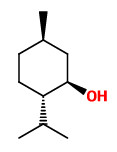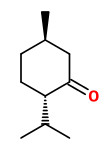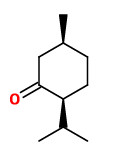Mentha arvensis L. - syn.Mentha austriaca Jacq. - Lamiaceae
corn mint, field mint, wild mint, पुदीना Pudina (Hindi), Japanese mint, menthol mint, Acker-Minze, Korn-Minze
Perennial herb, 10-30(-60)cm high, pubescent, native to Europe and Asia, naturalized in North America; leaves short petioled, opposite, simple, coarsely serrated; flowers pale purple, in whorls on the stem at the bases of the leaves.
„The following chemical races based on essential oil composition, occur in North America: Type 1 - high in pulegone, isomenthone and menthone. Type 2 - high in linalool, cis-ocimene and trans-ocimene. Type 3 - high in cis-isopulegone and trans-isopulegone. Type 4 - high in cis- and trans-ocimene and in 1,8-cineol. These four chemotypes are not correlated with any of the morphological variations.“
[Variation in Mentha arvensis L.(Labiatae). I. The North American populations., Gill, L.S., Lawrence, B.M., Morton, J.K., Botanical Journal of the Linnean Society, 67(3), 1973, 213-232]
Main components in cornmint oils from Brazil, China and India were menthol (65.0% Brazil, 72.1% China, 75.5% India), menthone (14.8% Brazil, 11.1% China, 6.0% India), isomenthone (4.1% Brazil, 3.9% China, 2.7% India), menthyl acetate (2.3% Brazil, 0.7% China, 1.9% India), neomenthol (2.6% Brazil, 2.6% China, 2.8% India), isomenthol (0.4% Brazil, 0.7% China, 0.7% India), piperitone (1.8% Brazil, 0.9% China, 1.0% India), and pulegone (1.1% Brazil, 0.9% China, 0.5% India).
[Boelens, M. H. „Chemical characterization of cornmint oils.“ Perfumer & flavorist 18.5 (1993): 27-32]
The most potent odorants (highest FD factor, 6-10) of a Chinese cornmint (M.arvensis var.piperascens) oil were isomenthone (11.2%, minty dirty leafy), menthone (22.1%, minty clean cooling), 2,5-diethyltetrahydrofuran (0.03%, pungent solvent ether), (E)-ß-damascenone (trace, fruity woody berry), 1,8-cineole (0.4%, cooling eucalyptus), menthol (34.9%, cooling minty clean), pulegone (1.5%, heavy minty dirty), ß-ionone (heavy woody fruity), eugenol (0.04%, spicy clove sweet), linalool (0.1%, floral sweet creamy), (E,Z)-2,6-nonadienal (leafy floral cucumber), carvone (0.2%, spearmint fruity herbal), guaiacol (sweet smoky phenolic), 4-vinylguaiacol (smoky woody sweet), and five unknown compounds.
[Benn, Scot. „Potent odorants in peppermint and cornmint oils characterized by GC-O and AEDA.“ Perfumer & flavorist 23.5 (1998): 5-16]
The major components of the essential oil obtained from the aerial parts of M.arvensis growing in central India were menthol (71%), menthone (8%), isomenthone (5%) and neomenthol (3%).
[Chemical composition and antimycotic activity of the essential oils of corn mint (Mentha arvensis) and lemon grass (Cymbopogon flexuosus) against human pathogenic fungi. Pandey, A. K., Rai, M. K., Acharya, D., Pharmaceutical biology, Vol.41(6), 2003, 421-425]
„Japanese mint (or corn mint), Mentha arvensis, is the source of a major raw material for the flavours and fragrances industry. Distillation provides mint oil, and further processing (chilling) provides menthol crystals and dementholised mint oil. Production is now dominated by India, but in the first half of the 20th
century production was dominated by Japan, providing around 70% of global requirements from an estimated annual production of around 800 tons of arvensis oil, with the remaining demand supplied by China. Brazil then took over the position of dominant supplier, with annual production reaching 5,000 tons in the mid 1960’s. Extreme price and supply volatility resulted in the collapse of the Brazilian production sector and the re-entry of China as the major supplier during the 1980’s and the first half of the 1990’s. India entered the global market in the mid 1980’s and by the mid 1990’s production had reached 6,000 tons and India had taken over as dominant
supplier to the market…“
[ITC, 2014] PDF
see also:
„The majority of (-)-menthol is obtained by freezing the oil of Mentha arvensis to crystallize the menthol present. This „natural“ menthol is then physically separated by centrifuging the supernatant liquid (called dementholized cornmint oil) away from the menthol crystals. Any residual impurities are due to traces of Mentha arvensis oil, and these often impart a slight peppermint aroma to the menthol crystals.“
Menthol Background and Menthol Enantiomers - Organoleptic Properties, Leffingwell 2011

Kops et al., J., Flora Batava, vol.15 t.1178 (1877) plantgenera.org

Mentha arvensis, Dąbrówka, Poland (2025) © nescama CC BY-SA 4.0 inaturalist.org



